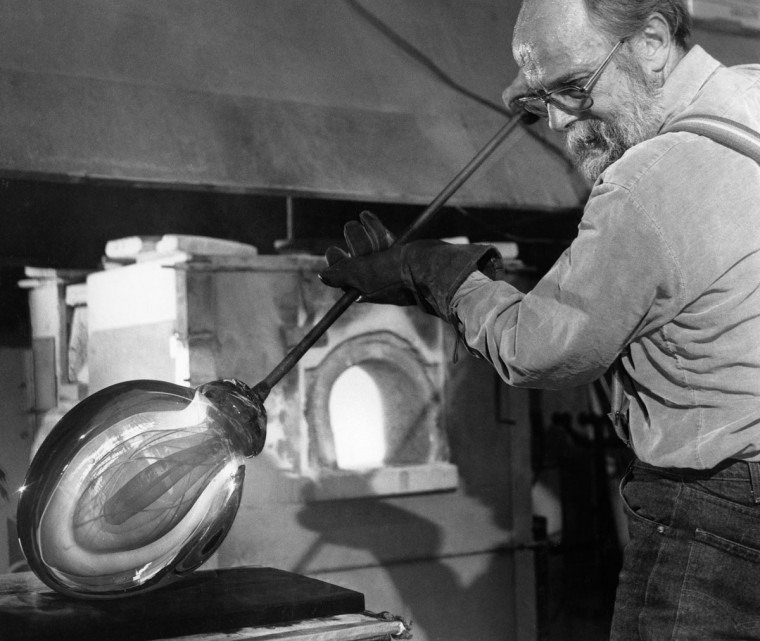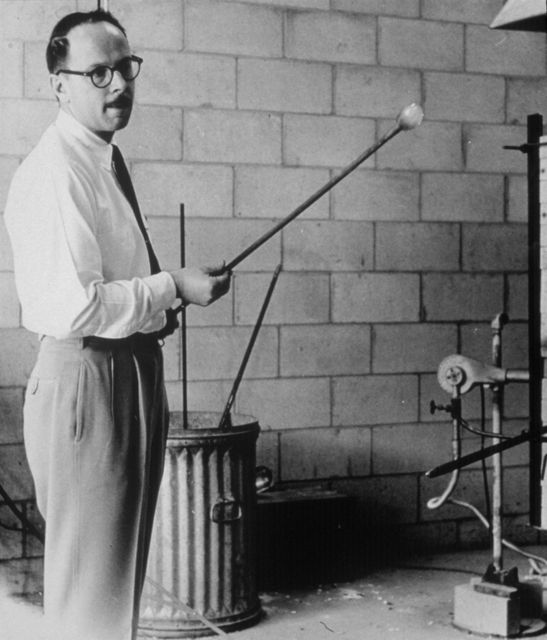Image courtesy of Fritz Dreisbach, photo by Gloria Schulman. Collection of the Rakow Research Library/Corning Museum of Glass.
Renowned glass artist, ceramist and the pioneer founder of the American studio glass movement, Harvey K. Littleton, died on Friday, Dec. 13 in Spruce Pine. He was 91. Littleton and his family moved to Western North Carolina in 1977. His presence added heft to the region’s nationally-recognized arts and crafts community, and he invigorated a burgeoning local glassblowing scene. His workshop attracted the nation’s top artists to study vitreography, a glass plate printmaking technique that he invented.
While Littleton was teaching ceramics at the University of Wisconsin-Madison, he began experimenting with glass as a medium for sculpture, rather than traditional practical objects. He had learned about glass growing up in Corning, N.Y., where his father was a research physicist for Corning Glass. As Littleton’s experiments became known, he was invited to teach two workshops at the Toledo Museum of Art in the spring of ‘62. Those workshops, conducted with fellow researcher Dominick Labino, demonstrated glassblowing using a small furnace that they had built for individual use. The demonstration defied the need for the industrial-size furnaces previously used, and is regarded as the beginning of the American studio glass movement.
“He was a very dynamic and strong-willed person,” says Joan Byrd, a professor of ceramics at Western Carolina University, and Littleton’s biographer and friend. “Glass has caught on, but in those days he was really heading upstream. It took a tremendous amount of energy and a tremendous amount of perseverance.” Byrd was also one of Littleton’s graduate students in the first studio glass classes that he offered after returning to the University of Wisconsin from the Toledo workshops.
 Image of Littleton in his Spruce Pine Studio, circa 1983, from Times Dispatch.
Image of Littleton in his Spruce Pine Studio, circa 1983, from Times Dispatch.
In 1976, Byrd invited Littleton to WCU to give a talk at North Carolina Glass ’76, the second all-glass art exhibition she organized there. During that trip, Littleton decided to move to WNC. He retired from the university the following year. “It was mostly because of the activity around the Penland school and the vitality of the community of artists in the area,” Byrd says. She adds, “If you think something is impossible, Harvey is going to make it happen. That’s how the studio glass movement happened — he made it happen.” The region’s lush, foggy green mountains, she says, also reminded Littleton’s wife, Bess, of her home in Hawaii. The artist set up his studio in Spruce Pine, just miles from the Penland campus. He later served on the school’s board of trustees, and as board chair, and helped expand the school’s glass program.
“Harvey was a larger-than-life personality,” says Jean McLaughlin, executive director at Penland School of Crafts. “He loved to experiment and encouraged so many other artists to reach beyond their known uses of materials.” She adds, “his presence helped to stimulate the incredible glass community that surrounds us in WNC.”
Littleton’s work has been collected and shown by art institutions including the Metropolitan Museum of Art and the Museum of Modern Art in New York, the Corning Museum of Glass and The Smithsonian. He was featured in the 2012 exhibition, Fire On The Mountain: Studio Glass in WNC, at the Asheville Art Museum.




Harvey Littleton was a great artistic innovator. We were fortunate to have him here in WNC. How about running an online gallery of some of his works? Your arts readers would appreciate that.
Glass Portfolio – red crown (Harvey Littleton), It is really prefect.